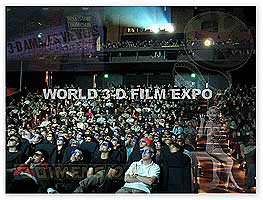Stereoscopic 3D/4D and Holographics
More 3D and 4D -'can you feel it?'
Essay by Al Razutis (2007)

We are headed for 'more 3D' these days, with the release of large-screen (eg. Imax 3D) films, and new 3D 'blockbuster' features by major studios for the new digital projection cinemas that have proliferated in North America and the world. This is all great news as stereoscopic 3D becomes digital motion-picture 'Stereo 4D?', with time & motion (not the 'jolts','smells', or ride experiences of what some call '4D') added as next dimension, reaching an ever wider public with more diverse content and autostereoscopic mobile delivery.
How we view stereo 3D subjectively
Stereoscopic 3D is perceived as a 'subjective realism' (in the arts, a synthetic and magical realism) that takes place in our brains (an important distinction) by providing the binocular (two eyes) viewer with a perspective pair of images, one for the left, one for the right eye. This image pair (stereoscopic image pair) is only a partial spatial representation (where is the vertical parallax?) to a human brain accustomed to seeing 3D space with horizontal side by side eyes. And, of course, the brain 'imagines' the rest, with a complexity of experience added to the 'magical realism' of stereoscopic 3D viewing.
The stereoscopic 3D image is not a spatial representation that is independent of the viewer's eyes (separate left and right eye views) or the viewer's ability to 'fuse' the two images into one 'spatial representation' via stereopsis.
Stereoscopic 3D is not Holographic 3D
Stereoscopic 3D is not holographic 3D (never was, never will be) and the difference is fundamentally tied to 'what is recorded': in stereoscopic 3D a pair of 2D 'binocular views' are recorded and focused on a film plane (or 2D projection screen, or eyes) as 'stereo pair' for the brain to reconstruct as a 3D image; in holographic 3D a 'interference volume' of laser emission, interfering with laser reflection from scene (as modulation), is recorded without focusing the light on a plane (as in photography), but by the photo plate situated in the interference volume. To view a stereo 3D rendering you require binocular vision where each view is perceived separately by left and right eye. In holographic 3D the image requires no separation devices, can be seen without 3D glasses, from any vantage point, and contains vertical parallax in addition to the typical binocular horizontal parallax. You can 'look over the image' in a hologram, not just side to side around it as in stereo 3D.
Note: If you want to compare a 'stereoscopic pair' 3D image with a 'holographic' 3D image, simply display both side by side, as was done at the 2010 stereo 3D and holographic exhibition 'Deja Vu' exhibition. Unless the viewer is hopelessly biased (and culturally impaired), the distinctions will become immediately apparent, and most 'obvious' when the holographic image appears to be 'suspended in space' (focused in space), whereas the stereoscopic 3D image pair (seen without glasses) is simply a flat 'double image' containing parallax information in the disparity between the two eye views.
The simple but awe-inspiring qualities of 'basic transmission' holograms reveal the fascinating differences between stereoscopy and holographic spatial representation. The popularized (and mistaken for true holograms) 'stereograms' which use motion-picture image strips to depict a stereoscopic moving image in space are a hybrid of stereoscopy and holographics. They combine many 'stereo' pairs/photographs and holographic 'printing' techniques and are a transitory and experimental form of '4D'. The stereogram is also limited to horizontal parallax.
Stereoscopic 3D cinema - video brings us high production values and actors, awesome sets, new motion-picture environments and CG FX in forms that were before impossible. These are certainly remarkable achievements and beyond what holography was capable of previously. We see a current explosion of 'short subject' stereoscopic 3D films, produced around the world, that are creating a visual 3D language in stereoscopic 3D that will be the foundations of future 'holographic' movies and story telling.
Holographic 4D Movies Borrow A Language
Stereoscopic 4D has borrowed from 2D cinema since its inception, and so shall holographic 4D movies borrow from all its predecessor forms. Borrow what? You may ask. Borrow the asethetic and formal language of expression is how all new media begins. Therefore, we continue to design and produce works both in stereoscopic 3D and holography. The magic of stereoscopic 3D motion-picture art makes possible unique creations and content, and the diversity of potential subject matter is yet to be delivered to mass markets in any holographic form on such a scale. Present fascinations with "Pepper's Ghost" motion-picture illusions of superimposing a projected virtual image (2D or 3D movie) in a real space continue to illustrate our culture's fascination with spatial representation in moving images. These illusions are mistakenly called "holographic but the fascination and future remains holographic.
The potentials of holographic art and the future 4D holographic cinema remain to be fully realized, but not for long. The future is here, and it is indeed holographic. and Visual Alchemy Studios and Al Razutis are dedicated to making it happen.
Holographic Motion-Picture Systems - Photos in 3D